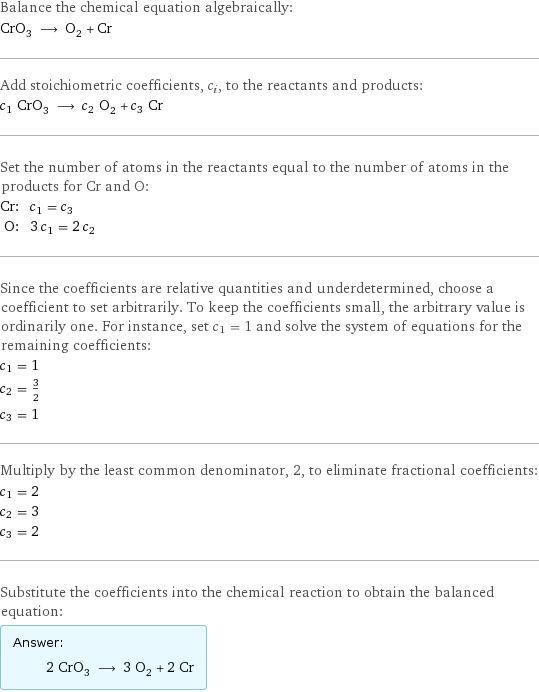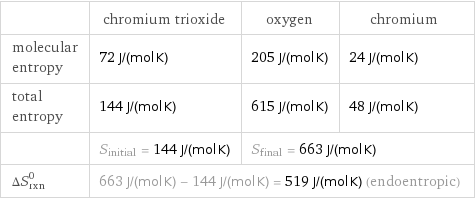Input interpretation

CrO_3 chromium trioxide ⟶ O_2 oxygen + Cr chromium
Balanced equation

Balance the chemical equation algebraically: CrO_3 ⟶ O_2 + Cr Add stoichiometric coefficients, c_i, to the reactants and products: c_1 CrO_3 ⟶ c_2 O_2 + c_3 Cr Set the number of atoms in the reactants equal to the number of atoms in the products for Cr and O: Cr: | c_1 = c_3 O: | 3 c_1 = 2 c_2 Since the coefficients are relative quantities and underdetermined, choose a coefficient to set arbitrarily. To keep the coefficients small, the arbitrary value is ordinarily one. For instance, set c_1 = 1 and solve the system of equations for the remaining coefficients: c_1 = 1 c_2 = 3/2 c_3 = 1 Multiply by the least common denominator, 2, to eliminate fractional coefficients: c_1 = 2 c_2 = 3 c_3 = 2 Substitute the coefficients into the chemical reaction to obtain the balanced equation: Answer: | | 2 CrO_3 ⟶ 3 O_2 + 2 Cr
Structures

⟶ +
Names

chromium trioxide ⟶ oxygen + chromium
Reaction thermodynamics
Entropy

| chromium trioxide | oxygen | chromium molecular entropy | 72 J/(mol K) | 205 J/(mol K) | 24 J/(mol K) total entropy | 144 J/(mol K) | 615 J/(mol K) | 48 J/(mol K) | S_initial = 144 J/(mol K) | S_final = 663 J/(mol K) | ΔS_rxn^0 | 663 J/(mol K) - 144 J/(mol K) = 519 J/(mol K) (endoentropic) | |
Equilibrium constant
![Construct the equilibrium constant, K, expression for: CrO_3 ⟶ O_2 + Cr Plan: • Balance the chemical equation. • Determine the stoichiometric numbers. • Assemble the activity expression for each chemical species. • Use the activity expressions to build the equilibrium constant expression. Write the balanced chemical equation: 2 CrO_3 ⟶ 3 O_2 + 2 Cr Assign stoichiometric numbers, ν_i, using the stoichiometric coefficients, c_i, from the balanced chemical equation in the following manner: ν_i = -c_i for reactants and ν_i = c_i for products: chemical species | c_i | ν_i CrO_3 | 2 | -2 O_2 | 3 | 3 Cr | 2 | 2 Assemble the activity expressions accounting for the state of matter and ν_i: chemical species | c_i | ν_i | activity expression CrO_3 | 2 | -2 | ([CrO3])^(-2) O_2 | 3 | 3 | ([O2])^3 Cr | 2 | 2 | ([Cr])^2 The equilibrium constant symbol in the concentration basis is: K_c Mulitply the activity expressions to arrive at the K_c expression: Answer: | | K_c = ([CrO3])^(-2) ([O2])^3 ([Cr])^2 = (([O2])^3 ([Cr])^2)/([CrO3])^2](../image_source/39b759187691e105085fdbc756f1c8e0.png)
Construct the equilibrium constant, K, expression for: CrO_3 ⟶ O_2 + Cr Plan: • Balance the chemical equation. • Determine the stoichiometric numbers. • Assemble the activity expression for each chemical species. • Use the activity expressions to build the equilibrium constant expression. Write the balanced chemical equation: 2 CrO_3 ⟶ 3 O_2 + 2 Cr Assign stoichiometric numbers, ν_i, using the stoichiometric coefficients, c_i, from the balanced chemical equation in the following manner: ν_i = -c_i for reactants and ν_i = c_i for products: chemical species | c_i | ν_i CrO_3 | 2 | -2 O_2 | 3 | 3 Cr | 2 | 2 Assemble the activity expressions accounting for the state of matter and ν_i: chemical species | c_i | ν_i | activity expression CrO_3 | 2 | -2 | ([CrO3])^(-2) O_2 | 3 | 3 | ([O2])^3 Cr | 2 | 2 | ([Cr])^2 The equilibrium constant symbol in the concentration basis is: K_c Mulitply the activity expressions to arrive at the K_c expression: Answer: | | K_c = ([CrO3])^(-2) ([O2])^3 ([Cr])^2 = (([O2])^3 ([Cr])^2)/([CrO3])^2
Rate of reaction
![Construct the rate of reaction expression for: CrO_3 ⟶ O_2 + Cr Plan: • Balance the chemical equation. • Determine the stoichiometric numbers. • Assemble the rate term for each chemical species. • Write the rate of reaction expression. Write the balanced chemical equation: 2 CrO_3 ⟶ 3 O_2 + 2 Cr Assign stoichiometric numbers, ν_i, using the stoichiometric coefficients, c_i, from the balanced chemical equation in the following manner: ν_i = -c_i for reactants and ν_i = c_i for products: chemical species | c_i | ν_i CrO_3 | 2 | -2 O_2 | 3 | 3 Cr | 2 | 2 The rate term for each chemical species, B_i, is 1/ν_i(Δ[B_i])/(Δt) where [B_i] is the amount concentration and t is time: chemical species | c_i | ν_i | rate term CrO_3 | 2 | -2 | -1/2 (Δ[CrO3])/(Δt) O_2 | 3 | 3 | 1/3 (Δ[O2])/(Δt) Cr | 2 | 2 | 1/2 (Δ[Cr])/(Δt) (for infinitesimal rate of change, replace Δ with d) Set the rate terms equal to each other to arrive at the rate expression: Answer: | | rate = -1/2 (Δ[CrO3])/(Δt) = 1/3 (Δ[O2])/(Δt) = 1/2 (Δ[Cr])/(Δt) (assuming constant volume and no accumulation of intermediates or side products)](../image_source/c57c2c86329532218f3991a3b30d8e1b.png)
Construct the rate of reaction expression for: CrO_3 ⟶ O_2 + Cr Plan: • Balance the chemical equation. • Determine the stoichiometric numbers. • Assemble the rate term for each chemical species. • Write the rate of reaction expression. Write the balanced chemical equation: 2 CrO_3 ⟶ 3 O_2 + 2 Cr Assign stoichiometric numbers, ν_i, using the stoichiometric coefficients, c_i, from the balanced chemical equation in the following manner: ν_i = -c_i for reactants and ν_i = c_i for products: chemical species | c_i | ν_i CrO_3 | 2 | -2 O_2 | 3 | 3 Cr | 2 | 2 The rate term for each chemical species, B_i, is 1/ν_i(Δ[B_i])/(Δt) where [B_i] is the amount concentration and t is time: chemical species | c_i | ν_i | rate term CrO_3 | 2 | -2 | -1/2 (Δ[CrO3])/(Δt) O_2 | 3 | 3 | 1/3 (Δ[O2])/(Δt) Cr | 2 | 2 | 1/2 (Δ[Cr])/(Δt) (for infinitesimal rate of change, replace Δ with d) Set the rate terms equal to each other to arrive at the rate expression: Answer: | | rate = -1/2 (Δ[CrO3])/(Δt) = 1/3 (Δ[O2])/(Δt) = 1/2 (Δ[Cr])/(Δt) (assuming constant volume and no accumulation of intermediates or side products)
Chemical names and formulas

| chromium trioxide | oxygen | chromium formula | CrO_3 | O_2 | Cr name | chromium trioxide | oxygen | chromium IUPAC name | trioxochromium | molecular oxygen | chromium
Substance properties

| chromium trioxide | oxygen | chromium molar mass | 99.993 g/mol | 31.998 g/mol | 51.9961 g/mol phase | solid (at STP) | gas (at STP) | solid (at STP) melting point | 196 °C | -218 °C | 1857 °C boiling point | | -183 °C | 2672 °C density | | 0.001429 g/cm^3 (at 0 °C) | 7.14 g/cm^3 solubility in water | very soluble | | insoluble surface tension | | 0.01347 N/m | dynamic viscosity | | 2.055×10^-5 Pa s (at 25 °C) | odor | odorless | odorless | odorless
Units
